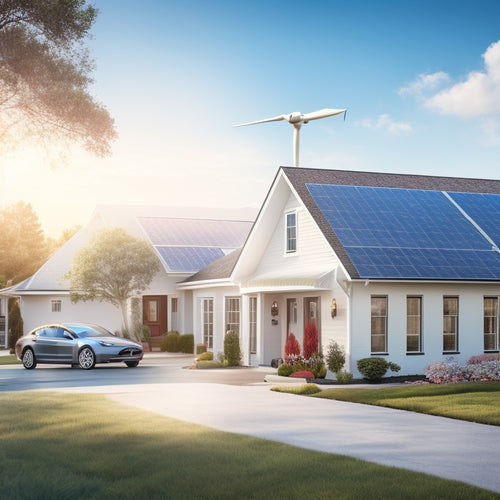
5 Essential Design Considerations for Off-Grid Farm Systems
Share
When designing an off-grid farm system, you need to take into account five essential factors to guarantee a reliable and sustainable power supply. First, assess your energy requirements by conducting an energy audit and evaluating your energy infrastructure. Next, select suitable solar panels based on factors like efficiency, durability, and cost. Then, optimize your system configuration to prevent overheating and reduce losses. You'll also need to guarantee sufficient energy storage capacity and mitigate environmental factors like climate resilience and wildlife damage. By taking into account these factors, you'll be well on your way to creating a thriving off-grid farm system that meets your unique needs - and there's more to explore to make it a success.
Key Takeaways
• Conduct an energy audit to identify energy consumption and opportunities for efficiency improvements in the off-grid farm system.
• Select suitable solar panel types based on factors like efficiency, durability, and cost, and consider tilt angles and shading analysis for optimal energy production.
• Optimize system configuration by configuring the solar array and battery bank, implementing load balancing, and ensuring proper pipe sizing to reduce losses.
• Ensure sufficient energy storage capacity to provide a stable power supply during low solar irradiance, and select storage solutions based on battery life expectancy and depth of discharge.
• Mitigate environmental factors by prioritizing climate resilience in material selection, using weather-resistant materials, and implementing erosion-control measures and wildlife-deterrent systems.
Assessing Energy Requirements
To accurately design an off-grid farm system, you must first determine the total energy requirements of your farm, including the energy needed to power farm equipment, lighting, and other essential systems. This involves conducting a thorough energy audit to identify areas of energy consumption and opportunities for efficiency gains.
Load profiling is a critical step in this process, as it helps you understand your farm's energy usage patterns and identify peak demand periods. By analyzing your energy usage data, you can identify the most energy-intensive systems and optimize their performance.
Energy auditing is another vital component of evaluating energy requirements. This involves evaluating your farm's energy infrastructure, including electrical distribution systems, lighting, and HVAC systems. By conducting a detailed energy audit, you can identify areas of inefficiency and opportunities for improvement.
This information will help you design an off-grid farm system that meets your energy needs while minimizing waste and reducing your environmental footprint. By taking a holistic approach to energy management, you can create a sustainable and resilient off-grid farm system that supports your farm's operations and contributes to a more sustainable future.
Selecting Suitable Panel Types
With your energy requirements assessed, you're now ready to select suitable solar panel types that can efficiently meet your off-grid farm system's energy demands. When choosing the right solar panels, take into account factors such as efficiency, durability, and cost. You'll also want to take into account the specific needs of your farm, including the amount of space available for installation and the local climate.
Here's a comparison of popular solar panel types:
| Panel Type | Efficiency | Cost |
| Monocrystalline | 15-20% | High |
| Polycrystalline | 12-15% | Medium |
| Thin-Film | 7-14% | Low |
When selecting panels, also take into consideration the importance of tilt angles and shading analysis. Proper tilt angles can increase energy production by up to 10%, while shading analysis can help identify potential obstacles to energy production. By carefully selecting the right panel type and taking into account these essential factors, you'll be well on your way to a thriving off-grid farm system.
Optimizing System Configuration
You'll need to configure your solar array and battery bank to optimize energy production and storage, ensuring your off-grid farm system runs efficiently and reliably. This involves load balancing, which distributes the electrical load across multiple strings to prevent overheating and reduce energy losses.
Proper pipe sizing is also important, as undersized pipes can lead to pressure drops, reducing system performance. Confirm your pipes are sized correctly to minimize friction losses and optimize water flow.
When designing your system, consider the maximum power point tracking (MPPT) of your solar array. This will help you optimize energy production and reduce energy losses. Additionally, take into account the depth of discharge (DOD) of your batteries to make sure you're not over-discharging them, which can reduce their lifespan.
Ensuring Energy Storage Capacity
Sufficient energy storage capacity is essential to ensure that your off-grid farm system can provide a stable and reliable power supply, even during periods of low solar irradiance or extended periods of cloud cover. This is particularly critical for farms that rely heavily on automated systems, such as irrigation and livestock feeding, which require a consistent power supply to function at their best.
When selecting energy storage solutions, take into account the battery life expectancy, which is typically between 5-15 years, depending on the technology and usage patterns. It's also important to factor in the depth of discharge (DOD), which is the percentage of the battery's capacity that's used during each cycle. A higher DOD can reduce the battery's lifespan.
| Battery Type | Depth of Discharge (DOD) | Battery Life Expectancy |
|---|---|---|
| Lead-Acid | 50% | 5-7 years |
| Lithium-Ion | 80% | 10-12 years |
| Nickel-Cadmium | 60% | 8-10 years |
Mitigating Environmental Factors
Environmental factors such as extreme temperatures, humidity, and wildlife can greatly impact the performance and longevity of your off-grid farm system, so it's vital to mitigate their effects through careful system design and component selection.
You'll want to prioritize climate resilience when selecting materials and designing your system's layout. For instance, using durable, weather-resistant materials can help your system withstand harsh weather conditions. It's also imperative to implement measures to prevent soil erosion, which can compromise your system's foundation and lead to costly repairs.
You can achieve this by incorporating erosion-control measures, such as terracing, contour farming, or planting vegetation that helps hold the soil in place. Additionally, consider using wildlife-deterrent systems, such as fencing or repellents, to protect your crops from damage.
Frequently Asked Questions
Can I Connect My Off-Grid Farm System to the Grid in the Future?
'You're planning ahead! Yes, you can connect your off-grid farm system to the grid in the future, thanks to Grid Interoperability. Design with Future Scalability in mind to guarantee a seamless shift, and you'll be ready to integrate when the time comes.'
How Do I Handle System Maintenance and Repairs Remotely?
"You'll need an army of tech-savvy ninjas to tackle system maintenance and repairs remotely, but with remote access and virtual assistants, you'll be a master of your off-grid farm system, effortlessly troubleshooting and resolving issues from anywhere."
Are There Any Special Considerations for Farm Systems in Extreme Weather?
When designing your farm system, you'll want to prioritize weather resilience by incorporating climate adaptability measures, such as storm surge protection, freeze protection systems, drought mitigation strategies, and hurricane resistance design to guarantee your system thrives.
Can I Use a Single System to Power Multiple Farm Locations?
"As you weave your off-grid farm system together, you're wondering if one powerhouse can fuel multiple farms. The answer is yes, with strategically placed distribution hubs and microgrids, you can efficiently power multiple locations, creating a resilient and connected agricultural network."
Are There Any Government Incentives for Off-Grid Farm Systems?
You'll be glad to know that yes, there are government incentives for off-grid farm systems, including tax credits and grant funding opportunities, which can greatly offset your system's cost, making sustainable farming more accessible to you.
Related Posts
-

Essential Accessories for Heavy Riders of E-Bikes
As a heavy rider of an e-bike, you need specialized gear that caters to your unique needs. Start with safety essentia...
-

Charging Points in Rural Areas: 5 Key Insights
When driving through rural areas, you'll face a shortage of charging points, making EV ownership stressful and inconv...
-

Why Homeowners Are Embracing DIY Energy Independence
By taking control of your energy needs, you're breaking free from the uncertainty of utility bills and embracing a se...


